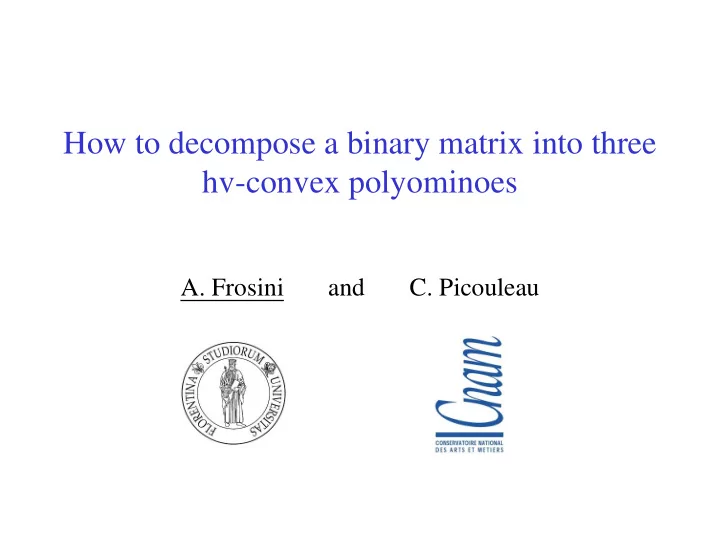

How to decompose a binary matrix into three hv-convex polyominoes A. Frosini and C. Picouleau
Definitions polyomino hv-convex set A discrete set of points whose elements are A discrete set of points whose elements are connected (here represented as a set of cells on a horizontally and vertically convex squared surface) polyomino + hv-convex set = hv-polyomino
Definition of the problem and previous results n -decomposition : 3 -decomposition : given a binary matrix, we want to efficiently given a binary matrix, we want to efficiently decompose it into at most n hv -polyominoes, if decompose it into at most 3 hv -polyominoes, if possible, otherwise give failure. possible, otherwise give failure. Previous results : -deciding if a binary matrix can be decomposed into at most n h -convex matrices is NP-complete (reduction from 3-Partition ) - the problem 3 -decomposition with respect to hv -convex matrices is NP-complete (reduction from 3-vertex-coloring ) - the problem 2 -decomposition both with respect to hv -convex matrices and hv -polyominoes can decided in polynomial time
Polynomial time algorithm for 3-decomposition Input: a binary matrix A Output: a decomposition of A into at most 3 hv -polyominoes, if possible, otherwise FAILURE Strategy: mark with 3 labels, say x , y , and z , the elements of A according to their belonging to 3 polyominoes X , Y , and Z that may constitute the final solution. The labels are assigned starting from those elements of A where no ambiguities are allowed.
Polynomial time algorithm for 3-decomposition Input: a binary matrix A Output: a decomposition of A into at most 3 hv -polyominoes, if possible, otherwise FAILURE Step 1: perform a preprocessing to avoid trivial cases Step 2: start the labeling with the elements that lie on rows having two holes
Polynomial time algorithm for 3-decomposition Input: a binary matrix A Output: a decomposition of A into at most 3 hv -polyominoes, if possible, otherwise FAILURE Step 1: perform a preprocessing to avoid trivial cases Step 2: start the labeling with the elements that lie on rows having two holes Step 3: proceed with labeling the rows having one single hole (regarding each hole as a point of a permutation matrix)
Polynomial time algorithm for 3-decomposition Input: a binary matrix A Output: a decomposition of A into at most 3 hv -polyominoes, if possible, otherwise FAILURE Step 1: perform a preprocessing to avoid trivial cases Step 2: start the labeling with the elements that lie on rows having two holes Step 3: proceed with labeling the rows having one single hole Step 4: label the columns having one single hole in the external areas
Polynomial time algorithm for 3-decomposition Input: a binary matrix A Output: a decomposition of A into at most 3 hv -polyominoes, if possible, otherwise FAILURE Step 1: perform a preprocessing to avoid trivial cases Step 2: start the labeling with the elements that lie on rows having two holes Step 3: proceed with labeling the rows having one single hole Step 4: label the columns having one single hole Step 5: complete the borders of the three polyominoes in order to maintain the hv - convexity, if possible, otherwise give FAILURE
Three open problems - find a polynomial time generalization of the algorithm for the decomposition into k different hv - polyominoes; - motivated from practical problems in Intensity Modulated Radiation Therapy (IMRT), extend the algorithm to the three-dimensional case; - explore the connections between our problem and the two-sided permutation matrices in order to simplify the algorithm and improve its efficiency.
Recommend
More recommend